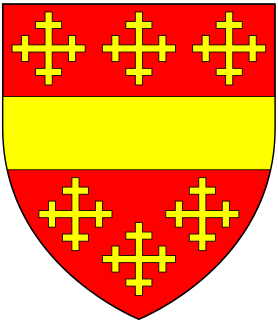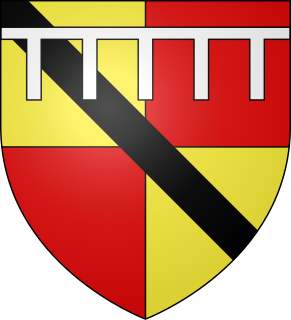
Durand of Gloucester (d. circa 1096) was Sheriff of Gloucestershire in 1086 and was one of the tenants-in-chief of King William the Conqueror in Gloucestershire and elsewhere, with a total of 63 holding listed in the Domesday Book of 1086. [1]

Durand of Gloucester (d. circa 1096) was Sheriff of Gloucestershire in 1086 and was one of the tenants-in-chief of King William the Conqueror in Gloucestershire and elsewhere, with a total of 63 holding listed in the Domesday Book of 1086. [1]
He was the heir of his brother Roger de Pitres (d. pre-1083), Sheriff of Gloucestershire from about 1071. [2] He died in about 1096 when his heir became his nephew (Roger's son) Walter of Gloucester (died 1129), hereditary Sheriff of Gloucestershire in 1097 and in 1105–6, [3] and Castellan of Gloucester Castle (also seemingly Constable of England under King Henry I (1100–1135)) [4]
Walter's son was Miles FitzWalter of Gloucester, 1st Earl of Hereford (died 1143) (alias Miles of Gloucester), [5] a great magnate based in the west of England, hereditary Constable of England and Sheriff of Gloucestershire. Miles inherited vast landholdings in Wales from his wife Sibyl de Neufmarché, daughter and heiress of Bernard de Neufmarché (died 1125), Lord of Brecon, and acquired others himself, but the nucleus of his feudal barony (known as the "Barony of Miles of Gloucester") was the fiefdom of his great-uncle Durand of Gloucester. [6]
Both Durand and his brother Roger de Pitres were buried in Gloucester Abbey (St. Peter's Abbey) in Gloucester [7] (since 1541 Gloucester Cathedral).

Miles FitzWalter of Gloucester, 1st Earl of Hereford was a great magnate based in the west of England. He was hereditary Constable of England and Sheriff of Gloucestershire.

Gloucester Castle was a Norman-era royal castle situated in the city of Gloucester in Gloucestershire, England. It was demolished in 1787 and replaced by Gloucester Prison.
Robert de Stafford was an Anglo-Norman nobleman, the first feudal baron of Stafford in Staffordshire in England, where he built as his seat Stafford Castle. His many landholdings are listed in the Domesday Book of 1086.
Richard Fitz Pons was an Anglo-Norman nobleman, active as a marcher lord on the border with Wales.
Walter of Gloucester was an early Anglo-Norman official of the King of England during the early years of the Norman conquest of the South Welsh Marches. He was a sheriff of Gloucester and also a Constable under Henry I.

Gloucester Abbey was a Benedictine abbey in the city of Gloucester, England. Since 1541 it has been Gloucester Cathedral.
Walter of Hereford was a holder of the feudal title Baron Bergavenny or Lord Abergavenny in the Welsh Marches in the mid twelfth century.
Bertha of Hereford, also known as Bertha de Pitres, was the daughter of Miles de Gloucester, 1st Earl of Hereford, and a wealthy heiress, Sibyl de Neufmarché. She was the wife of William de Braose, 3rd Lord of Bramber to whom she brought many castles and Lordships, such as Brecknock, and Abergavenny.
Humphrey III de Bohun of Trowbridge Castle in Wiltshire and of Caldicot Castle in south-east Wales, 5th feudal baron of Trowbridge, was an Anglo-Norman nobleman and general who served King Henry II as Lord High Constable of England.
Sibyl de Neufmarché, Countess of Hereford, suo jure Lady of Brecknock, was a Cambro-Norman noblewoman, heiress to one of the most substantial fiefs in the Welsh Marches. The great-granddaughter of Gruffydd ap Llywelyn, king of Wales, Sibyl was also connected to the nobility of England and Normandy. Sibyl inherited the titles and lands of her father, Bernard de Neufmarché, Lord of Brecon, after her mother, Nest ferch Osbern, had declared her brother Mahel to have been illegitimate. Most of these estates passed to Sibyl's husband, Miles de Gloucester, 1st Earl of Hereford, as her dowry. Their marriage had been arranged personally by King Henry I of England in the spring of 1121. Sibyl, with her extensive lands, was central to the King's plans of consolidating Anglo-Norman power in south-east Wales by the merging of her estates with those of Miles, his loyal subject on whom he relied to implement Crown policy.

Walter II de Beauchamp, of Elmley Castle in Worcestershire, was hereditary Sheriff of Worcestershire.
Roger de Pitres, a Norman, was the Sheriff of Gloucester under William the Conqueror and constable of Gloucester Castle.
William Devereux was an Anglo-Norman nobleman living during the reigns of kings William I, William II, and Henry I of England. The Devereux, along with the Baskervilles and Pichards, were prominent knightly families along the Welsh marches at the beginning of the twelfth century, and linked to the Braose and Lacy lordships of the region. William Devereux's descendants would later give rise to the Devereux family of Hereford, and the Devereux Viscounts of Hereford and Earls of Essex.
Robert fitzRoger was an Anglo-Norman nobleman and Sheriff of Norfolk and Suffolk and Northumberland. He was a son of Roger fitzRichard and Adelisa de Vere. FitzRoger owed some of his early offices to William Longchamp, but contined in royal service even after the fall of Longchamp. His marriage to an heiress brought him more lands, which were extensive enough for him to be ranked as a baron. FitzRoger founded Langley Abbey in Norfolk in 1195.

The feudal barony of Okehampton was a very large feudal barony, the largest mediaeval fiefdom in the county of Devon, England, whose caput was Okehampton Castle and manor. It was one of eight feudal baronies in Devonshire which existed during the mediaeval era.

The Domesday Book of 1086 lists in the following order the tenants-in-chief in Devonshire of King William the Conqueror:
Geoffrey Talbot was an Anglo-Norman nobleman in medieval England. Holding lands around Swanscombe in Kent, he is often considered to have been the feudal baron of Swanscombe. Besides his lands, he was also given custody of Rochester Castle. His heir was his son, also named Geoffrey.

The feudal barony of Clifford was a feudal barony with its caput baroniae at Clifford Castle in Herefordshire, England.

John fitz Richard was an Anglo-Norman soldier, Baron of Halton and hereditary Constable of Chester. Historical records refer to him as "John, Constable of Chester". He died at Acre in the Holy Land.

The Constable of Chester was a mediaeval hereditary office held by the Barons of Halton. The functions of the Constable are unclear, possibly they related to the custody of Chester Castle, as was the main function of most mediaeval constables, but Sanders (1960) says the office-holder was constable for the entire County Palatine.